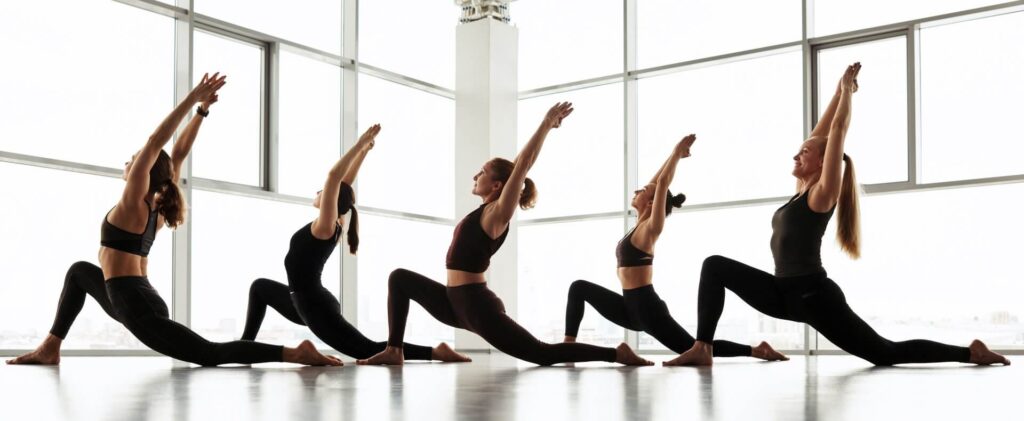“Explore the enriching Low Lunge (Anjaneyasana), a versatile yoga pose suitable for beginners and intermediates, promoting flexibility and balance.” Low Lunge Anjaneyasana (Beginner to Intermediate)
Low Lunge, or Anjaneyasana in Sanskrit, is a dynamic yoga pose that accommodates beginners and intermediate practitioners. This pose extends a wide range of benefits, including improved flexibility, hip opening, and enhanced balance. In this article, we’ll delve into the origins, symbolism, advantages, and a step-by-step guide to performing Low Lunge.
Anjaneyasana Meaning
The name “Anjaneyasana” draws its roots from Hindu mythology, specifically from the story of Lord Hanuman, the monkey god, and his mother, Anjana. This pose honors Lord Hanuman’s heroic leap, symbolizing strength, devotion, and courage.
Benefits Low Lunge
Low Lunge (Anjaneyasana) offers a myriad of advantages, benefiting both body and mind:
- Hip Flexor Stretch: The pose deeply stretches the hip flexors, making it ideal for individuals with tight hips due to prolonged sitting.
- Thigh Strengthening: It engages and strengthens the quadriceps, hamstrings, and calf muscles, enhancing leg strength.
- Balance Improvement: Practicing Low Lunge challenges balance and coordination, leading to enhanced stability.
- Backbend Action: The pose incorporates a gentle backbend, promoting spinal flexibility and relieving tension in the lower back.
- Emotional Release: Low Lunge encourages the release of stored emotions and stress, creating a sense of emotional balance.
Step-by-Step Instructions Low Lunge

- Starting Position: Begin in a standing position at the front of your yoga mat with your feet hip-width apart and your arms relaxed by your sides.
- Step Back: Inhale as you take a large step backward with your right foot, ensuring that the ball of your right foot touches the ground.
- Knee Alignment: Lower your hips toward the floor, bending your left knee at a 90-degree angle. Ensure your left knee is directly above your left ankle.
- Back Leg Placement: Your right leg should be extended straight behind you, with the right toes pointing down and the top of the right foot resting on the mat.
- Pelvic Tilt: Tilt your pelvis slightly forward, allowing for a gentle arch in your lower back.
- Arms: Extend your arms overhead, palms facing each other, and fingers pointing toward the ceiling. Feel a gentle stretch in your upper body.
- Gaze: Keep your head in a neutral position or gently tilt it upward to gaze at your fingertips.
- Hold and Breathe: Remain in the pose for 30 seconds to one minute, breathing deeply and evenly. Maintain balance and focus.
- Release: To exit the pose, release your hands and step your right foot forward to meet your left. Return to a standing position.
- Switch Sides: Repeat the sequence with your left foot stepping back to ensure balanced practice.
Low Lunge Variations and Modifications
Use yoga blocks under your hands if reaching the floor is challenging. For added stability, you can practice Low Lunge with your back knee on the ground.
Tips for a Deeper Practice
Focus on drawing your hips forward to deepen the stretch in your hip flexors. Engage your core to support your lower back and maintain balance. Breathe consciously and allow your breath to guide you deeper into the pose.
Preparation Poses Low Lunge
- Mountain Pose (Tadasana): Begin your practice with Mountain Pose to center yourself and establish proper alignment.
- Forward Fold (Uttanasana): Uttanasana can help warm up the hamstrings and lower back, making it an excellent preparation for Low Lunge.
Low Lunge Alternatives
When practicing yoga, if you find yourself unable to do the Low Lunge – Anjaneyasana, don’t worry! There are alternative poses you can try to reap similar benefits. Remember, it’s all about finding what works best for your body and enjoying your yoga practice. Keep exploring and have fun!
- Child’s Pose (Balasana): After practicing Low Lunge, relax in Child’s Pose to release tension and restore calmness.
- Downward-Facing Dog (Adho Mukha Svanasana): Downward Dog can help stretch and realign the spine after practicing standing poses.
Final Thoughts
Low Lunge (Anjaneyasana) provides a versatile and accessible opportunity for yoga practitioners to enhance flexibility, balance, and emotional well-being. As you gracefully arch your back and reach for the sky, embrace the mythological symbolism of Lord Hanuman’s courage and devotion. Whether you’re a beginner or an intermediate yogi, Low Lunge can enrich your practice and contribute to a harmonious body and mind.
FAQ Anjaneyasana
What is Anjaneyasana and its benefits?
Anjaneyasana is a yoga pose also known as Low Lunge. It stretches the hips, and quadriceps, and opens the chest. The benefits include improved balance, flexibility, and leg and core muscle strengthening.
What does Anjaneyasana symbolize?
Anjaneyasana symbolizes strength, courage, and devotion.
What does Anjaneyasana mean in Sanskrit?
A Low lunge pose in yoga.


